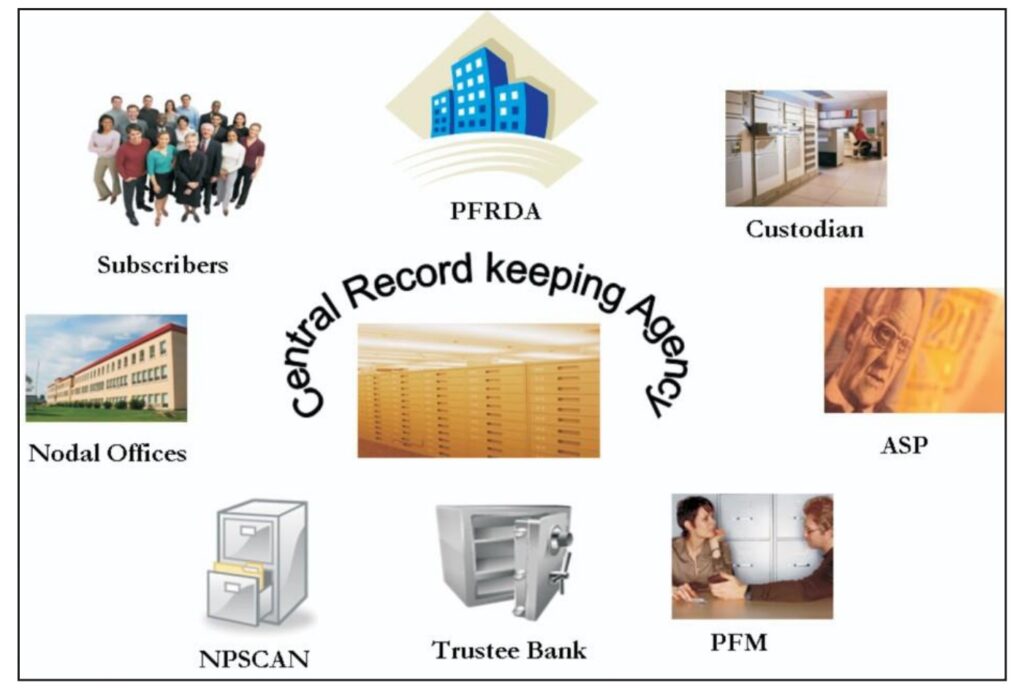नई पेंशन योजना
NPS -NATIONAL PENSION SYSTEM IN VIEW OF PFRDA
Questions | Answer |
What is the | As per PFRDA Act 2013, PFRDA of pension funds and for matters connected therewith or |
What is National Pension System? | “National Pension System” (NPS) means the contributory
The Central Government has introduced the Defined specified dates, |
Who are covered | NPS is applicable to all employees joining services of |
How does NPS differ from old pension? | The old pension scheme of Government of India is based on
NPS is referred as Defined Contribution |
5 | What is a PRAN? |
PRAN is an acronym |
6 | Are bank Aadhar, PAN, CKYC identifier and FATCA declaration mandatory for opening |
As per the current Common Subscriber Registration Form ( |
7 | What are the KYC documents required for generation of PRAN? | Identity and address proof are the key KYC documents. Details |
8 | Can PRAN be generated for employees who have already |
No. Registration of subscribers is not permitted under |
9 | Can a subscriber use the same if |
Yes. As PRAN is unique and portable across employment & |
10 | What is the process of Inter Sector Shifting (ISS), |
A subscriber can shift from his current |
11 | Can a subscriber obtain/ than one | No, an individual is permitted to have only one PRAN which is unique, permanent and portable across
If a |
12 | Who can be a nominee and how are the |
Only an individual can become a nominee. Subscriber can nominate a maximum of three nominees |
13 | Who can |
A subscriber, at the time of joining the National Pension
Ø Ø |
14 | What is Non-IRA PRANs? the advantages & |
Non-IRA subscribers are those whose PRANs were generated on Advantages & Benefits of IRA Compliance to Subscribers: |
|
|
1. 2. 3. 4. 5. 6. |
15 | What one changes in PRAN data? | Subscriber can update his / her details in Tier I in CRA system by submitting a change request |
16 | What are Account |
The Principal Accounts Office (PrAO)/ Directorate of
1. 2. 3. Monitor the resolution of grievances raised 4. |
17 | Is NPS applicable to employees of Central Autonomous Bodies? |
Yes. In line with the decision of GOI to introduce NPS for |
18 | How can Bodies join |
Department of Expenditure, Ministry of Finance , GOI vide |
19 | Is transition from contributory Provident Fund to Defined |
Yes. The organizations are permitted to shift to NPS in The other detailed operational features are as follows,
a. The b. In c. Recurring monthly d. The |
20 | Is NPS applicable to employees of State Autonomous Bodies? |
Many State Governments have adopted NPS architecture and |
21 | Is NPS applicable to Members of All India |
Yes and contribution to NPS is mandatory for all members after 1/1/2004 as specified in No 25014/14/2001-AIS II Dt 8/9/2009 issued by Ministry of Personnel, Public Grievances and Pensions. |
22 | From where Information Brochure? | For accessing the latest (updated) Subscriber Information Brochure, subscribers may be visit PFRDA |
23 | What is Tier I and Tier II account? they different? |
Under NPS, two types of account would be available to | ||
24 | How much can a subscriber contribute towards his Tier I account? |
A subscriber contributes 10% of his Salary On voluntary basis, subscriber may contribute | ||
25 | How can one open what ? |
An active Tier I Any government employee who has an active Tier I account Subscriber can choose one Pension Fund and decide | ||
26 | What is the investment-pattern for Government employees? | Following is the investment pattern for Govt | ||
Particulars | Exposure Limits |
| ||
Government Securities & related investments | Upto 50% | |||
Debt Instruments & related investments | Upto 45% | |||
Short term | Upto 5% | |||
|
| Equity & related investments | Upto 15% |
|
Asset backed trust | Upto 5% | |||
Three funds | ||||
For accessing the latest guideline, the pension fund section may be visited | ||||
27 | Is there SCF and remittance of funds? |
The timelines are specified in OM No 1 (7) 2003 / TA / Partfile/ 279 Dt 2/9/2008 issued by Department of Expenditure, Office of CGA, Ministry of Finance; applicable PAO/CDDOs should upload | ||
29 | How I can get Statement of Transactions (SoT)/check my NPS | Subscriber s can access their SoTs at NPS using their | ||
30 | Are there contributions for the central government employees? | Tax Benefits:
(i) On
(ii) On
(iii) From |
31 | How does grievances/ complaints? | A subscriber can contact his associated Subscriber can also raise |
32 | What to do if the grievance has not been | Every grievance lodged shall be disposed off within a
For Complete information on the issue, please refer to |
33 | How I Exit/withdrawal /partial withdrawal? | Please |
34 | Whether any Mobile application for NPS is available? | Yes, NPS app may be downloaded from play store in Android and from Subscribers
· · · · · ·
· · · · · ·
·
|

Disclaimer:- The content, including but not limited to information, news, and videos, presented on this platform has been sourced from various outlets. Our intention is to empower individuals with easily accessible information, under the belief that “Knowledge Is Power” and to promote general awareness. Please be aware that we do not endorse or verify the authenticity of the provided content. Users are advised to exercise discretion and judgment when relying on any information obtained from this platform.